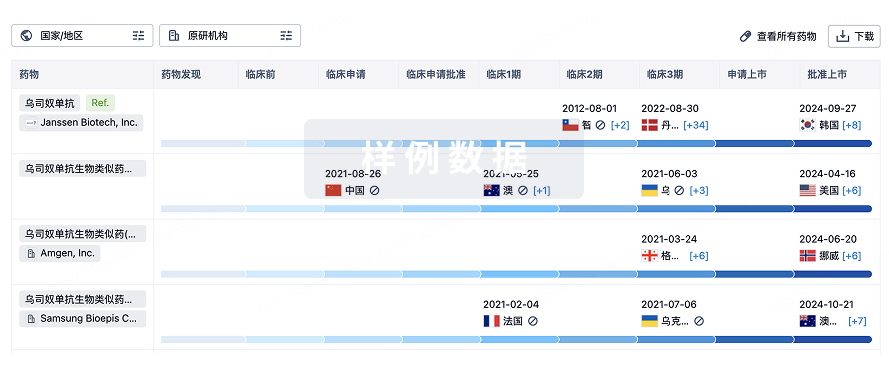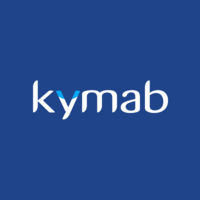预约演示
更新于:2025-11-27
Amlitelimab
更新于:2025-11-27
概要
基本信息
原研机构 |
非在研机构- |
权益机构- |
最高研发阶段临床3期 |
首次获批日期- |
最高研发阶段(中国)临床3期 |
特殊审评- |
登录后查看时间轴
结构/序列
Sequence Code 14863545H

来源: *****
Sequence Code 16875279L

来源: *****
关联
25
项与 Amlitelimab 相关的临床试验NCT07146750
An Open-label, Phase 1, Randomized, Parallel Design Study to Determine the Bioequivalence and Investigate the Safety and Tolerability of Subcutaneous Amlitelimab Delivered by 2 Different Devices in Healthy Adult Participants
This is a single-center, open-label, randomized, single-dose, parallel, Phase 1, 4-arm study designed to determine the bioequivalence and investigate the safety and tolerability profiles of subcutaneous amlitelimab delivered by 2 different devices at 2 different total doses in healthy adult participants.
开始日期2025-08-25 |
申办/合作机构 |
CTR20242734
CONQUEST 治疗硬化症平台临床研究:一项评价试验药物在系统性硬化症相关间质性肺疾病受试者中的安全性和有效性的多中心、双盲、随机、安慰剂对照、IIb 期平台临床研究
本研究的主要目的是根据第 52 周治疗期结束时 FVC(mL;在 SSc-ILD 研究受试者中测量)较基线的变化来评价 IP 相比安慰剂的有效性。
本研究的次要目的是评价如下内容:
? 根据第 52 周如下指标较基线的变化来评价 IP 相比安慰剂的有效性:
o 通过高分辨率计算机断层扫描(HRCT)定量 ILD(QILD)-全肺(WL)[QILD-WL]测量的肺部受累;以及
o 通过慢性疾病治疗功能评估(FACIT)-呼吸困难评分测量的呼吸困难(严重程度和功能限制)。
? 第 52 周时在弥漫性皮肤型 SSc 研究受试者中通过修订版弥漫性 SSc 综合反应指数(CRISS)评分测量的总体治疗反应;以及
? IP 的安全性和耐受性。
开始日期2025-06-27 |
申办/合作机构 北京MEDPACE医药科技有限公司 [+2] |
NCT06686628
An Open-label, Drug-drug Interaction Study to Investigate the Effects of Amlitelimab on the Pharmacokinetics of Selected Cytochrome P450 Substrates in Adult Participants With Moderate-to-severe Atopic Dermatitis
This is an open-label, single group, 2-period, Phase 1, single-sequence study. The study duration will be up to 342 days. The treatment period will be up to Week 29, where Week 29 is defined as End of Treatment (last amlitelimab administration at Week 25).
The number of visits will be 23 or 21 visits for participants who decide to continue amlitelimab therapy in the long-term extension study LTS17367 (RIVER-AD) study.
The number of visits will be 23 or 21 visits for participants who decide to continue amlitelimab therapy in the long-term extension study LTS17367 (RIVER-AD) study.
开始日期2024-11-20 |
申办/合作机构 |
100 项与 Amlitelimab 相关的临床结果
登录后查看更多信息
100 项与 Amlitelimab 相关的转化医学
登录后查看更多信息
100 项与 Amlitelimab 相关的专利(医药)
登录后查看更多信息
17
项与 Amlitelimab 相关的文献(医药)2025-09-02·JOURNAL OF THE EUROPEAN ACADEMY OF DERMATOLOGY AND VENEREOLOGY
Disproportionate quality of life decline and unaddressed limitations in amlitelimab atopic dermatitis trial.
Letter
作者: Ting, Tsai Ling ; Chen, Shiuan-Chih
2025-07-24·Immunotherapy
Amlitelimab, an anti-OX40 ligand antibody, for atopic dermatitis: a plain language summary of STREAM-AD clinical study
Article
作者: Blauvelt, Andrew ; Weidinger, Stephan ; Wei, Xiaodan ; Rynkiewicz, Natalie ; Hurbin, Fabrice ; Yen, Karl ; Adelman, Samuel ; Weber, Christine ; Worm, Margitta ; Lynde, Charles ; Wong, Wanling ; Lee, Chih-Hung ; Reich, Adam ; Foley, Peter ; Papp, Kim A. ; Bernigaud, Charlotte ; Kataoka, Yoko ; O’Malley, John T. ; Davey, Sonya ; Solente, Anne-Catherine
2025-06-01·Journal of Scleroderma and Related Disorders
Design of CONQUEST, a novel, randomized, placebo-controlled, Phase 2b platform clinical trial to investigate new treatments for patients with early active systemic sclerosis with interstitial lung disease
Article
作者: Assassi, Shervin ; Steffgen, Juergen ; Benton, Wade W ; Maher, Toby M ; Gordon, Gregory ; Maslova, Karina ; Khanna, Dinesh ; Evnin, Luke B
Objective::
Safe, effective therapies are urgently needed for patients with systemic sclerosis. However, clinical trial recruitment is challenging given the limited number of people with systemic sclerosis and further restrictions imposed by eligibility criteria. Innovative approaches are needed to accelerate development of new therapies. This article describes the rationale and trial design for CONQUEST (NCT06195072), a novel platform clinical trial sponsored by the Scleroderma Research Foundation, a not-for-profit organization.
Methods::
CONQUEST is a multicentre, double-blind, randomized, placebo-controlled, Phase 2b platform trial evaluating the efficacy, safety and pharmacodynamics of multiple investigational products to treat early active systemic sclerosis with interstitial lung disease versus placebo. The primary objective is to evaluate change from baseline to Week 52 in forced vital capacity (mL). Secondary objectives include evaluating changes from baseline to Week 52 in high-resolution computed-tomography-assessed lung involvement and dyspnoea, and overall treatment response (measured using the revised composite response index in diffuse systemic sclerosis score in participants with diffuse cutaneous systemic sclerosis).
Results::
Patients will be enrolled across more than 150 centres in over 25 countries. Recruitment started on 15 April 2024.
Conclusion::
As the first platform clinical trial in the rheumatology field, CONQUEST aims to meaningfully accelerate the development of new therapies for early active systemic sclerosis. Depending on regimen-specific results, trial data could be used to plan and design a Phase 3 trial or may be used alone or together with another registrational trial to establish substantial evidence of effectiveness and safety. The first molecules to be studied, amlitelimab and nerandomilast, both have a strong scientific rationale to modify underlying disease processes in systemic sclerosis.
ClinicalTrials.gov::
Platform Clinical Study for Conquering Scleroderma (CONQUEST); NCT06195072;
https://www.clinicaltrials.gov/study/NCT06195072
191
项与 Amlitelimab 相关的新闻(医药)2025-11-24
·i艾科研
医药行业正迎来一场前所未有的变革,GLP-1类药物横扫全球市场,新一代“药王”之争进入白热化,而中国创新药也在这场竞争中首次崭露头角。
2025年的全球制药行业格局正在经历一场深刻洗牌。随着上半年销售额数据的公布,诺和诺德的司美格鲁肽以166.32亿美元的销售额终结了默沙东Keytruda多年的霸主地位,但后者仍以151.61亿美元紧追不舍。礼来的替尔泊肽则以147.34亿美元紧随其后,前三强差距仅约10亿美元,全年“药王”之争充满悬念。
在这场白热化的竞争中,中国创新药实现了历史性突破——百济神州的泽布替尼以17.42亿美元销售额首次跻身全球药品销售额TOP50榜单,成为首个闯入该榜单的国产创新药。
01
三足鼎立:全球药王争霸赛
2025年上半年,GLP-1药物成为全球制药市场最大亮点。诺和诺德的司美格鲁肽凭借Ozempic(降糖注射版)、Rybelsus(降糖口服版)和Wegovy(减重版)三大版本,终结了Keytruda多年霸主地位。
然而,礼来的替尔泊肽正以惊人速度追赶,上半年销售额同比增长121.3%,增速居全球之首。
更加引人注目的是,替尔泊肽在第二季度单季销售额达85.80亿美元,反超司美格鲁肽的80.34亿美元。如果维持这一势头,它有望问鼎全年“药王”宝座。
礼来在美国市场的GLP-1产品处方量占比已达53.3%,超过了诺和诺德的46.1%。
02
十大药企:营收与创新双重评定
根据滴度医贸网2025年发布的全球十大制药公司榜单,强生以药品板块约557.5亿美元营收位居榜首,辉瑞、默沙东紧随其后。
这份榜单不仅关注营收,更综合了市值、研发投入、管线创新度和平台技术等多个维度。
在IDEA Pharma发布的被誉为“医药奥斯卡”的2025年医药创新指数和医药发明指数排行榜中,礼来和阿斯利康分列两个榜单首位。
礼来重返巅峰得益于多个关键因素:其Zepbound获批成为首个用于治疗肥胖成人中重度阻塞性睡眠呼吸暂停的处方药;Kisunla获批用于治疗阿尔茨海默病;还扩大了免疫学产品组合。
03
战略布局:从“广泛撒网”到“精准卡位”
面对行业竞争压力与技术迭代加速,全球药物研发格局正经历深刻调整。各大药企纷纷战略聚焦,通过大幅削减非核心管线精简运营。
强生在双抗产品领域持续发力。Tecvayli上半年销售额3.17亿美元,同比增长18.2%;Talvey销售额达1.92亿美元,增长52%。
在2025年ASCO大会上,强生披露的三抗产品JNJ-5322的Ⅱ期临床试验推荐剂量下客观缓解率达86%,被寄予厚望。
艾伯维在自免领域表现突出,Skyrizi上半年收入78.48亿美元,同比增长65.8%;Rinvoq收入37.46亿美元,增长48.5%,成功接棒Humira。
辉瑞则调转“船头”,转向下一代抗肿瘤疗法。上半年辉瑞有不下9项BD合作达成,且大多涉及肿瘤领域。其ADC产品合计收入超15亿美元,收购Seagen所获得的产品多数在放量增长。
04
技术前沿:AI制药、ADC与双抗平台
2025年,人工智能技术在药物研发中的应用愈发深入。多家药企对如何利用AI提高制药生产力,缩减成本,支持下一代药物的研发进行了重要分享。
《快公司》发布的“2025年最具创新力的10家生物技术公司”榜单中,多家企业凭借AI技术在生命科学领域的革命性应用而入选。
Basecamp Research通过其专有自然知识图谱训练AI进行蛋白质设计,为医药、食品和工业等领域提供生物解决方案。
Nabla Bio的生成式蛋白设计平台通过AI驱动设计,仅需靶点蛋白序列和/或结构即可从头设计治疗性抗体,并成功靶向G蛋白偶联受体(GPCR),取得该领域的突破性进展。
ADC药物继续领跑肿瘤治疗领域。阿斯利康的Enhertu上半年营收12.62亿美元,同比增长38%。
全球ADC药物市场规模在2025年Q1达39亿美元,创历史新高,同比增长24%。
双特异性抗体也在多个疾病领域展现出潜力。罗氏凭借眼科(Vabysme)和血友病(Hemlibra)双抗建立壁垒,法瑞西单抗2025年Q1同比增长18%,Hemlibra同期增长11%。
05
临床突破:下半年值得关注的关键研究
2025年下半年,一批足以改写治疗格局的关键临床研究结果即将揭晓。
礼来的口服GLP-1小分子orforglipron的III期Attain-1研究结果备受期待。作为全球首个有望获批的口服小分子肠促胰岛素类药物,化学合成的特性使其具备大规模生产的优势。
2025年4月,礼来公布了orforglipron针对糖尿病患者的III期临床研究结果,这一积极数据直接推动礼来市值上涨约1000亿美元。
赛诺菲的OX40L单抗amlitelimab的III期Coast-1、Shore研究结果将成为该药未来获批上市的关键证据。
凭借独特机制和广泛的适应症潜力,赛诺菲相信amlitelimab拥有与度普利尤单抗比肩的潜力,预估其年销售额峰值可超50亿欧元。
康方生物与Summit联合开发的PD-1/VEGF双抗药物依沃西单抗,去年凭借在III期Harmoni-2研究PFS终点上击败默沙东Keytruda引发轰动,但其OS数据尚未成熟。
该研究的最终分析预计2025年底完成,届时OS获益能否显现,将成为决定PD-1/VEGF类药物前景的“终局答案”。
06
中国力量:从“跟跑”到“并跑”
中国创新药在全球市场的崛起成为2025年一大亮点。百济神州的泽布替尼首次跻身全球药品销售额TOP50榜单,位列第46位。
2025年第一季度,泽布替尼首次跃居全球BTK抑制剂市场的整体份额首位,上半年全球销售额达17.42亿美元,同比增长54.7%。
泽布替尼的成功源于其卓越的临床数据,特别是在全球头对头研究中展现出优于伊布替尼的疗效和安全性。
百济神州上半年实现收入与利润双增长,首度扭亏为盈:营业总收入175.18亿元,同比增长46.0%,归母净利润达4.5亿元。
此外,礼来与信达生物共同推进的玛仕度肽于今年6月27日在中国获批上市,该药是“双靶点”药物,研究显示其因副作用而停药的概率显著低于司美格鲁肽和替尔泊肽。
中国本土药企作为“后浪”蓄势待发,司美格鲁肽专利权2026年到期,目前丽珠、石药、华东医药等6家企业的仿制药已申报上市。
全球制药巨头竞争正未有穷期。制药行业五大趋势——GLP-1与肥胖治疗成为新增长极;肿瘤管线整合与并购加速;精准医学与生物标志物快速落地;专利悬崖倒逼管线多元化;生物制药产能回流本土——正在重塑行业格局。
随着年底一系列关键临床数据的公布,以及中国创新药在国际市场上的持续突破,2026年的全球制药行业必将迎来更多变局。
END
中药鉴定、科研数据分析,分子对接、网络药理学等扫码咨询。
2025-11-21
“痒到怀疑人生”是特应性皮炎患者的真实写照。这种被很多人误以为是“普通湿疹”的疾病,实则是全球非致命性皮肤疾病头号负担,全球有2.3亿人深受其扰,我国患者数量超过7000万。
特应性皮炎不仅是一种皮肤病,更是一种系统性疾病。患者常有剧烈瘙痒,严重时皮肤糜烂、渗出、结痂,约91%患者每天都有瘙痒症状,瘙痒持续时间平均长达10.7年,3/4患者因此失眠,严重影响生活质量。
01
治疗理念的革新:从“控制症状”到“对因治疗”
多年来,特应性皮炎的治疗主要依赖外用激素和免疫抑制剂,但效果有限且副作用较大。北京大学人民医院张建中教授指出,我国特应性皮炎诊疗已迈入“多元精准”时代。
随着对疾病机制认识的深入,针对特定发病环节的靶向药物不断涌现,为患者提供了更为精准、有效的治疗选择。现在,临床医生可以根据患者具体情况,制定个体化治疗方案,实现更佳的治疗效果。
02
已获批的四大新药
截至目前,我国国家药品监督管理局已批准4种用于中重度特应性皮炎的新药:
度普利尤单抗注射液:这是首个获批用于特应性皮炎的生物制剂,可选择性抑制白介素-4和白介素-13信号通路。适用于6岁以上儿童、青少年的中重度特应性皮炎,成人一般2周注射一次。
乌帕替尼缓释片:口服高选择性JAK1抑制剂,被批准用于成人和12岁及以上青少年的难治型、中重度特应性皮炎。
阿布昔替尼片:同样为高选择性JAK1抑制剂,为中重度特应性皮炎的治疗提供了新选择。
司普奇拜单抗:2024年9月,中国自主研发的司普奇拜单抗(商品名:康悦达)正式获批上市,填补了特应性皮炎领域国产生物制剂的空白。这款“中国创造,世界新药”以卓越的临床数据改写治疗标准。
03
临床研究中的创新药物
除了已获批的药物,还有更多创新疗法正在临床研究中,覆盖不同作用机制,为患者带来新希望。
1. IL-4Rα单抗类药物
这类药物通过阻断IL-4和IL-13信号通路,直接作用于特应性皮炎的核心发病机制:
司普奇拜单抗:国内首个上市的国产IL-4抑制剂,目前针对青少年及儿童群体开展临床试验
GR1802注射液(智翔金泰):正在进行III期临床试验
SSGJ-611注射液(三生国健):已获准开展6-18岁青少年临床研究
MG-K10注射液(麦济生物):具有长半衰期特性,有望实现每月一次给药
QX005N注射液(荃信生物):当前储备适应症最多的药物
AK120注射液(康方生物):可显著降低血清中代表2型炎症的TARC和IgE水平
2. IL-13单抗新药
来瑞组单抗(礼来):2023-2024年相继在欧盟和美国获批
曲罗芦单抗(LEO Pharma):已在多国获批用于成人和青少年患者
3. OX40单抗新药
这类药物通过阻断OX40信号通路,从源头上控制特应性皮炎的炎症过程,且具有长效性优势:
Rocatinlimab(安进公司):已进入三期临床试验阶段
BAT6026注射液(百奥泰):具有抗体依赖性细胞介导的细胞毒性作用增强功能
Amlitelimab(赛诺菲):采用“非耗竭性”作用机制,在不清除T细胞的情况下调节其功能
APG990注射液(Pogee Therapeutics):半衰期长约60天,支持每3至6个月进行一次潜在维持给药
4. JAK抑制剂类药物
JAK抑制剂通过阻断细胞内的炎症信号传导,有效缓解瘙痒和皮损:
TUL01101片(联邦制药):具有自主知识产权的高选择性JAK1抑制剂
LW402片(长森药业):新一代口服JAK1抑制剂
LNK01001胶囊(凌科药业):高选择性JAK1抑制剂,24小时内即可快速改善瘙痒
MH004乳膏(明慧医药):局部外用JAK抑制剂乳膏,避免全身性毒性
ICP-332口服药(诺诚健华):新型TYK2抑制剂,对JAK2的选择性高达400倍
艾玛昔替尼软膏(恒瑞医药):国产高选择性JAK1抑制剂,已完成Ⅲ期临床并申报上市
5. 其他创新机制药物
SIM0278(先声药业):Treg偏好型IL-2突变融合蛋白,可选择性激活调节性T细胞,帮助恢复机体免疫平衡,已进入Ⅱ期临床研究
罗氟司特乳膏:非激素类PDE4抑制剂,每日使用一次,作为外用制剂具有较高的用药便利
04
个体化治疗:如何选择适合自己的方案?
面对众多新药,患者该如何选择?张建中教授建议,特应性皮炎的治疗需遵循分级方案:
轻度患者:以外用药治疗为主,如外用激素、钙调磷酸酶抑制剂、芳香烃受体调节剂等。
中重度患者:需启动系统治疗,可根据情况选择口服小分子靶向药或生物制剂。
专家强调,特应性皮炎像高血压、糖尿病一样是慢性病,需要长期管理,患者应规范用药,不可症状稍有好转就自行停药。
以上新药均在临床当中,最小招募群体为3个月的特应性皮炎,如果您当前的治疗效果不佳或想尝试新的药物,可以选择参与临床治疗,临床不收取任何费用,有需要的特应性皮炎患者可以扫描下方二维码申请,初筛通过后将会安排前往三甲医院面诊就医:
新药正在临床招募,免费用,有补贴,当地三甲医院用药,赶紧扫码报名!
扫码进特应性皮炎/湿疹/结节性痒疹病友群
声明:本文内容90% 以上基于原创,少量素材借助AI辅助,所有内容都经过严格审核和复核。图片来源于网络。本文内容仅做参考,不构成对任何药物或诊疗方案的推荐、推广或宣传,也不可替代专业医疗建议。如有问题,请咨询医疗卫生专业人士。
2025-11-21
·雪球
摘要◼2025Q3业绩回顾:•EliLilly在GLP-1类药物驱动下,收入端同比+52%,其中Tirzepatide单季度营收首次超过100亿美元,同比+131%、环比+18%。与美国政府达成GLP-1价格协议,降价及减少保险受益人自付金额从而获得Medicare及各州Medicaid扩大减重药物覆盖,同时对DTC渠道减重产品降价50美元/4支装,未来Orforglipron上市后将以最低剂量149美元、其他剂量不超过399美元价格进行供应。•NovoNordisk由于美国市场减重药物竞争日趋激烈及始终未能妥善解决的compoundedGLP-1药物影响,25Q3美国市场Ozempic及Wegovy分别同比+1%/+6%,年内已多次下调业绩指引。与美国政府达成GLP-1价格协议,MedicarepartD将于2026年开始试点覆盖Wegovy,Medicare/Medicaid/DTC渠道中销售的Semaglutide产品都将进一步降价,公司预计价格变动对2026年销售增长产生低个位数负面影响。•AstraZeneca、AbbVie、Amgen、Vertex、Sanofi、GSK等分别依靠核心产品继续放量及新产品带来的增量收入维持高个位数~低双位数增长;JNJ、Novartis、BMS、Gilead等由于核心产品专利到期后下滑拖累或MedicarePartDredesign影响,维持低~中个位数增长;Merck、Pfizer分别受到疫苗板块下滑及COVID-19相关产品收入波动影响,收入端低个位数增长或同比下滑;Roche、Regeneron由于眼科产品在美国市场由于支付端问题增速放缓拖累。•2025Q3,16家企业中共11家企业对全年营收和/或净利润/EPS进行了上调,主要由于新产品销售放量好于预期和/或专利到期产品下滑幅度低于预期等因素,另有4家维持,1家下调。◼MNC的产品在美国市场放量有多快?•我们统计了MNC药企2010-2014年间在美国市场上市的产品共计52款,剔除部分数据缺失、峰值销售额低于3亿美元或销售时长少于5年的产品后,剩余的34款产品在美国市场达峰的中位数时间为~8年,其中FIC产品(n=13)为~7年,罕见病产品(n=13)为~8年,突破性疗法/BTD产品(n=8)为~7年,生物制品(n=14)为~10年。海外药企25Q3业绩梳理❑海外制药企业2025Q3营收及2025全年指引❑中国区域销售表现◼共有7家海外药企披露了其在中国区域的具体销售数据,2025Q1-3单季度分别实现销售额合计484/430/436亿元(分别同比-6%/-18%/-4%);其中,Merck由于停止HPV疫苗向中国发货,25Q1-3国内销售48/29/27亿元(分别同比-62%/-77%/-62%),剔除Merck后单季度销售分别为436/401/409亿元(分别同比+12%/+1%/+7%);EliLilly受益于Tirzepatide在国内放量,单季度营收达到40亿元(同比+24%),NovoNordisk在胰岛素及罕见病产品驱动下同比+12%。❑EliLilly:Tirzepatide季度销售首次达到100亿美元,上调全年业绩指引◼25Q3Lilly实现全球销售176亿美元(CER+54%,下同),销量+62%,净价格-10%,销售增长主要由Mounjaro及Zepbound贡献,非肠促胰素产品销售+12%。上调全年业绩指引,收入指引由此前的600~620亿美元上调至630~635亿美元,GAAPEPS指引由此前的每股20.85~22.10美元上调至21.80~22.50美元,Non-GAAPEPS由此前的每股21.75~23.00美元上调至23.00~23.70美元。◼CVRM:MounjaroQ3销售65.2亿美元(同比+109%,季度环比+25%),US/ex-US市场分别35.5/29.7亿美元,分别同比+49%/+307%、环比+8%/+65%,截止25Q3末USNBRx占比达54%(25Q1/Q2末=46%/50%);Zepbound销售35.9亿美元销售(同比+185%,季度环比+6%),主要由美国市场贡献,截止25Q3末USNBRx占比71%(25Q1/Q2末=74%/68%),新患在CVStemplateplansaccesschange后反弹,总处方TRxSOM63%,较Q2末下滑2pp;Tirzepatide单季度合计销售101亿美元,同比+131%,环比+18%,美国incretin市场整体TRx占比58%(Q1/Q2末为53%/57%)。与美国政府达成GLP-1价格协议:1)从2026年4月1日起,医疗保险受益人为Zepbound(tirzepatide)和orforglipron自付金额不超过每月50美元。各州还将能够通过Medicaid扩大对Zepbound和orforglipron覆盖。礼来已经为orforglipron申请NationalPriorityVoucher以加速FDA审批。2)在FDA批准后,患有肥胖症的自付患者将能够通过LillyDirect的自付药房渠道获得这些药物。Zepbound多剂量笔将以最低剂量299美元提供,其他剂量不超过449美元(此前4支装的2.5mg价格349美元,其他剂量在平台折扣后均为499美元),价格与欧洲相似。Orforglipron将以最低剂量149美元提供,其他剂量不超过399美元。在研管线方面,Orforglipron肥胖伴T2DPh3ATTAIN-2数据读出,受试者接受6/12/36mgOrforglipron或安慰剂,第52周体重较基线变化-5.5%/-7.8%/-10.5%vs-2.2%pbo,A1C较基线变化-1.3%/-1.6%/-1.8%vs-0.1%pbo,礼来计划25年底提交减重适应症上市申请;Retatrutide首个肥胖伴骨关节炎Ph3临床研究预计25Q4读出;Muvalaplin启动首个CVOTPh3临床研究。◼肿瘤:Verzenio(Abemaciclib/阿贝西利)销售14.7亿美元(+7%),US/ex-US市场分别销售8.8/5.9亿美元(同比+47%/-23%);Jayprica(Pirtobrutinib,BTKi)销售1.4亿美元(+76%),LTM合计销售4.7亿美元。Inluryo(imlunestrant)获批上市用于治疗ER+/HER2-ESR1mutmBC。◼自免:Taltz(Ixekizumab,IL-17抗体)销售9.0亿美元(+2%);Omvoh(mirikizumab,IL-23p19)销售6500万美元(+60%),LTM合计销售2.3亿美元;Ebglyss(Lebrikizumab,IL-13)销售1.3亿美元,TRx较25Q2环比+41%,其中新患占比~40%。❑NovoNordisk:进一步下调全年业绩指引,与Pfizer竞价Metsera失败◼2025Q3诺和诺德实现销售收入750亿丹麦克朗(reported+5%,CER+11%),净利润为200亿丹麦克朗(-27%)。更新2025年业绩指引,不变汇率下营收增长由此前的8%~14%进一步下调至8%~11%,经营利润增长由此前的4%~10%下调至4%~7%。◼T2D:GLP-1和胰岛素类降糖药物25Q3销售收入合计达491亿丹麦克朗(+8%),胰岛素产品销售120亿丹麦克朗(+1%);GLP-1产品销售367亿丹麦克朗(+11%),其中Ozempic销售307亿丹麦克朗(同比+9%),US/ex-US市场分别213/94亿丹麦克朗(同比+1%/+8%),美国市场销售额增长部分获益于GtN折扣率及终端补库存,2025Q3美国GLP-1降糖总处方量同比增长>10%,Ozempic周度总处方量达到~670k(25Q2末为~690k),Tirzepatide为~737k;美国市场增加市场投入,并在直销渠道上线Ozempic产品。◼Obesity:25Q3减重产品收入211亿丹麦克朗(+18%),其中Wegovy销售额为204亿丹麦克朗(+23%),US市场125亿丹麦克朗(同比+6%),销量增长驱动,部分对冲净价格下降影响,截至2025年10月美国市场周度总处方量达到~271k(7月末为~282k,4月末为~210k,年初为~204k),同期礼来的Tirzepatide~474k(7月末为~419k,4月末为~333k,年初为~228k),与Tirzepatide进一步拉开差距;尽管FDA已将Semaglutide移出短缺名单,但compoundedGLP-1s销售规模仍在增长,据测算美国市场用药患者规模超过100万人;直销渠道(cashchannel)Wegovy处方占比由1月的~4%增长至目前的~10%,但仍低于此前的预期;持续加强与GoodRx及Costco等零售渠道合作。与美国政府达成GLP-1价格协议:1)MedicarepartD将于2026年开始试点覆盖诺和诺德的减肥药产品;2)MedicarePartD、Medicaid及美国的DTC自营渠道中销售的Semaglutide将进一步降价;3)诺和诺德预计,价格变动将于2026年全球销售增长产生低个位数的负面影响。与Pfizer就Metsera战不断升级,10月30日及11月5日,NovoNordisk在Pfizer最初73亿美元总价(49亿美元首付款+24亿美元CVRs)基础上先后报价至90亿美元及100亿美元总价(72亿美元现金收购50%non-voting优先股+至多28亿美元CVRs以收购剩余股权),但仍竞价失败,Pfizer最终以每股65.60美元现金收购Metsera全部流通普通股(对应~70亿美元)及每股最高20.65美元CVRs(共约22亿美元),总价约92亿美元完成对Metsera收购。◼MASH:52亿美元对价(47亿美元首付款+5亿美元CVRs)收购Akero获得其核心资产FGF21类似物Elfruxifermin,在此前的Ph2临床研究中28/50mgElfruxigermin在MASHF4stage患者中实现纤维化缓解21%/29%vs11%pbo(首个F4stage患者人群数据),目前Ph3临床SYNCHRONY研究进行中。◼中国市场:25Q3中国市场实现收入50亿丹麦克朗(+12%,增长主要由罕见病药物板块贡献),其中胰岛素产品销售23亿丹麦克朗(+8%),T2DGLP-1产品合计收入21亿丹麦克朗(+9%),其中Ozempic、Rybelsus、Victoza分别销售15.3/4.4/1.4亿丹麦克朗(分别-11%/+~9x/-12%),减重产品Wegovy+Saxenda合计销售1.2亿丹麦克朗(-31%)。❑JNJ:TREMFYA销售额同比增长40%,上调全年收入指引◼25Q3药品板块实现营收156亿美元(operational+5.3%,下同),连续两个季度超过150亿美元;分治疗领域,肿瘤65.3亿美元(+19.2%)、自免41.7亿美元(-10.6%)、神经20.2亿美元(+14.6%)、肺高压11.1亿美元(+0.4%)、心血管及代谢9.0亿美元(+1.2%)、传染8.3亿美元(-4.3%),增长主要由肿瘤及神经领域产品驱动。全年收入指引由此前的932~936亿美元(+5.1%~+5.6%)上调至935~939亿美元(+5.4%~+5.9%)。◼肿瘤:多发性骨髓瘤相关产品销售维持快速增长,DARZALEX(达雷妥单抗)实现销售36.7亿美元(+20%),整体份额+5.7pp,前线份额+9.0pp,联用TECVAYLI临床研究进行中;CARVYKTI(BCMACAR-T)实现销售5.2亿美元(同比+81%,环比+19%),增长主要由市场份额增加、新产能扩张驱动及ex-US市场扩张贡献,管理层重申对50亿美元销售峰值信心;TECVAYLI(BCMAxCD3双抗)及TALVEY(GPRC5DxCD3双抗)分别实现销售1.8亿美元(+30%)及1.2亿美元(+59%),communitysetting患者贡献增长。肺癌方面,EGFR/c-Met双抗Rybrevant(埃万妥单抗)联用EGFRT790M抑制剂Lazcluze(兰泽替尼)获批成为EGFR19号外显子缺失(ex19del)或L858R突变NSCLC患者的一线无化疗治疗方案,MARIPOSA研究中联合疗法较奥希替尼展现出OS优效,25Q3销售2.0亿美元。膀胱癌药械产品Inlexzo(2019年收购Taris)于9月上市,是首款获得FDA批准的能够在膀胱内持续释放药物的药械装置,用于治疗不可切除BCG无应答原位非肌层浸润膀胱癌,JNJ预计其峰值销售有望达到50亿美元。◼自免:TREMFYA(Guselkumab)实现销售14.2亿美元(+40%),已获批适应症均实现份额增长,其中IBD适应症份额提升显著贡献销售增量,JNJ预计其峰值销售有望达到100亿美元。STELARA(Ustekinumab)实现销售15.7亿美元(-42%),产品处于生命周期尾声,biosimilar分别于2024年7月、2025年1月进入欧洲及美国市场,专利到期后销售曲线参考Humira。与Protagonist合作推进的口服环肽IL-23抑制剂Icotrokinra已于7月提交银屑病NDA。◼神经:SPRAVATO(盐酸艾司氯胺酮鼻喷雾剂)是目前唯一获批的单药疗法,用于治疗伴有急性自杀意念或行为的成人抑郁症患者的抑郁症状,25Q3实现销售4.6亿美元(+61%);收购Intra-Celluar获得的精分及双向情感障碍药物CAPLYTA(lumateperone/卢美哌隆),已提交抑郁症sNDA申请,Ph3临床数据显示在现有ADT(抗抑郁疗法)基础上附加使用lumateperone第6周MADRA(蒙哥马利抑郁评价量表)评分较ADT单药进一步改善4.5/4.9分,25Q2营收首次并表,25Q3实现销售2.4亿美元(2024全年销售6.8亿美元)。❑AbbVie:年内第三次上调业绩指引,加大神经/精神领域布局◼25Q3AbbVie实现全球销售158亿美元(Operational+8.4%,下同),其中自免78.9亿美元(+11.2%)、神经28.4亿美元(+19.6%)、肿瘤16.8亿美元(-1.3%)、医美11.9亿美元(-4.2%)。年内第三次上调业绩指引,收入指引由此前的605亿美元上调至609亿美元,adjusteddilutedEPS指引由每股10.38~10.58美元上调至10.61~10.65美元(包括收购IPR&D及milestone费用美股-2.05美元)。◼自免:25Q3Skyrizi(利生奇珠单抗)销售47.1亿美元(+46%),Rinvoq(乌帕替尼)销售21.8亿美元(+34%),两款产品2025Q1-3在IBD适应症销售额较上年同期翻倍,在美国市场各线CDnewswitchingpatients总处方占比接近50%,各线UCinplaypatients占比约三分之一,Skyrizi全年指引由此前的171亿美元再次上调至173亿美元(主要来自银屑病及IBD贡献);Humira销售9.9亿美元(-56%),其中US/ex-US市场分别销售6.2/3.7亿美元(分别-65%/-19%),预计下滑至少将持续至2026年。研发进展方面,Rinvoq白癜风Ph3临床数据读出,达到48周主要及次要终点,较安慰剂显著改善身体及面部白癜风评分;IBD适应症扩大标签,对于已经使用过至少一种已获批的系统性疗法并且尚未使用TNFi且在临床上不推荐使用TNFi的人群中可提至TNFi前使用。◼肿瘤:25Q3板块整体实现销售16.8亿美元(-1%),其中Imbruvica(伊布替尼)销售7.1亿美元(-15%),全年收入指引由28亿美元上调至29亿美元,主要由于现有用药患者维持率好于预期;Venclexta(维奈克拉)销售7.3亿美元(+5%),全年指引由27亿美元上调至28亿美元,主要为CLL强劲需求驱动;Elahere(FRαADC)实现销售1.7亿美元,LTM合计销售6.3亿美元。◼神经:25Q3板块整体实现销售28.4亿美元(+20%),全年收入指引由102亿美元上调至105亿美元(Vyalev快速放量贡献1亿美元增量),其中Vraylar(卡利拉嗪)销售9.3亿美元(+7%),增长主要由I型双向情感障碍及抑郁市场份额提升贡献;BotoxTherapeutic销售9.9亿美元(+16%);新上市Vyalev(磷卡比多巴/磷左旋多巴复方),是FDA批准的首个基于左旋多巴的皮下24小时持续输注疗法,用于治疗晚期帕金森病成人患者的运动症状波动,25Q3实现销售1.4亿美元,主要为EU/JP市场贡献。研发进展方面,Tavapadon帕金森适应症提交NDA申请,单药治疗早期PD,或在口服levo/carbidopa后仍有运动症状波动的患者中作为附加疗法。此前,AbbVie以12亿美元对价收购Gilgamesh,其核心资产为Bretisilocin,一种短效5-HT2A受体激动剂+5-HT释放剂,可引起短暂的幻觉体验窗口,以治疗重度抑郁障碍。❑Gilead:上调HIV产品销售指引,TrodelvyHR+/HER2-mBC未达到主要终点◼2025Q3Gilead实现营收73亿美元(同比-2%,环比+4%),其中Veklury(瑞德西韦)收入2.8亿美元,剔除新冠收入后收入同比+4%,环比+2%;分治疗领域,HIV产品收入53亿美元(同比+4%,环比+4%)、肿瘤产品收入8.5亿美元(同比-3%,环比-7%)。◼HIV:BIKTARVY(BIC/FTC/TAF复方单片剂)实现销售37亿美元(同比+6%,环比+4%),美国市场份额~52%(HIV治疗市场整体增速2%~3%),预计美国市场LoE时间点延后至2036年;Descovy(FTC/TAF复方,每日一次口服,用于PrEP/暴露前预防)实现销售7.0亿美元(同比+20%,环比+7%),美国市场份额>45%,美国PrEP市场整体增速~14%;Yeztuugo(Lenacapavir,IMQ6M)于6月获得FDA批准上市用于HIVPrEP,25Q3实现销售3900万美元,上市至今累计销售5400万美元,美国市场保险覆盖达到~75%,目标26Q2达到~90%。基于BIKTARVY和Descovy销售表现,HIV产品全年收入增速指引由~3%上调至~5%。◼肿瘤:Trodelvy(Trop2ADC)销售3.6亿美元(同比+7%,环比-2%),mBC需求增长对冲mUC下滑;于ESMO公布两项TNBCPh3研究数据,ASCENT-03研究1LmTNBC不适用PD-(L)1人群mPFS=9.7vs6.9mochemo,ASCENT-041LmTNBC联用K药人群(CPS≥10)mPFS=11.2vs7.8moK药+chemo;1L内分泌疗法经治的HR+/HER2-mBC人群Ph3ASCENT-07研究,对照化疗未达到PFS终点,OS尚未成熟,但观察到获益趋势。细胞治疗产品整体收入4.3亿美元(同比-11%,环比-11%),其中Yescarta(CD19CAR-T,主要适应症为DLBCL/PMBCL/FL)3.5亿美元(同比-10%),美国市场需求下滑;Tecartus(CD19CAR-T,主要适应症为MCL/ALL)销售8300万美元(同比-15%)。Anito-celiMMAGINE-1研究4L+r/rMM预计25Q4更新数据;iMMagine-3研究2-4Lr/rMM完成首例患者给药,研究选取MDR-negative和PFS双终点。◼肝病:25Q3实现营收8.2亿美元(同比+12%,环比+3%),其中Epclusa(索非布韦/韦帕他韦,口服HCV泛基因型复方药物)销售3.7亿美元,Vemlidy(TAF,泰诺福韦)销售3.0亿美元;Livdelzi(PPARδ激动剂,用于治疗对熊去氧胆酸/UDCA反应不足或无法耐受的成人原发性胆汁性胆管炎/PBC患者)25Q3销售1.05亿美元,LTM销售合计2.5亿美元,Livdelzi于2024年8月取得FDA加速审批,Ph3验证性临床研究进行中。HEPCLUDEX(bulevirtide,HDV)美国市场提交BLA,预计2026H2获批上市,目前美国丁肝患者~4万人(~2%的HBV患者)。❑Sanofi:Dupixent销售同比+21%,上调全年收入增速指引◼25Q3Sanofi实现营收124亿欧元(reported+2.3%,CER+7.0%),其中Dupixent实现营收42亿欧元(CER+26.2%,下同)、疫苗产品实现营收34亿欧元(-7.8%)、新上市产品合计实现营收10亿欧元(+57.1%),其他药品实现营收38亿欧元(-3.8%)。◼自免:25Q3Dupixent/达必妥销售41.6亿欧元(+26.2%),其中US/ex-US市场分别为30.7/10.8亿欧元(分别+27.9%/+21.3%),美国市场单季度销售额首次突破30亿欧元,截至2025年8月的在用药患者数较上年同期增长>30%。在研管线方面,Amlitelimab(OX-40L抗体)AD适应症Ph3临床数据读出,受试者接受250mgQ4/12W或安慰剂,第24周EASI-75达到46%/50%vs28%pbo,vIGA-AD0/1达到27%/29%vs11%pbo,安慰剂调整后的有效性数据与Amgen的OX40抗体Rocatinamab接近,但低于IL-4Rα及IL-13抗体数据;Brivekimig(TNF/OX40L)HS适应症Ph2临床数据读出,第16周HiSCR75为54%vs22%pbo(adjustedRRD=29%),Ph2b临床启动入组;DuvakitugCD/UC适应症Ph3临床研究启动。◼疫苗:25Q3实现营收33.6亿欧元(-7.8%),25Q1-3实现营收59.0亿欧元(-0.7%),其中Beyfortus(RSV预防性抗体)Q3销售7.4亿欧元(+19.8%),流感/COVID-19产品销售15.3亿欧元(-16.8%),主要由于美国市场接种率低于往年同期水平。在研管线方面,儿童RSV疫苗(toddlerRSV)Ph3临床由于有效性原因终止。❑Amgen:Repatha一级预防数据读出,再次上调全年业绩指引◼2025Q3Amgen实现营收95.6亿美元(+12%),其中药品销售91亿美元增长12%、销量增长14%。更新全年业绩指引,营收指引由此前的350~360亿美元上调至358~366亿美元,Non-GAAPEPS由此前的每股20.20~21.30美元上调至20.60~21.40美元。◼非专科药:25Q3PCSK9抑制剂Repatha(依洛尤单抗)销售7.9亿美元(+40%),AHA2025年会公布首个一级预防Ph3临床VESALIUS-CV研究数据,在动脉粥样硬化或伴高风险糖尿病的一级预防人群中,使用Evolocumab140mgQ2W或安慰剂,中位数随访~4.6年,3P-MACE发生率分别为6.2%vs8.0%pbo(HR=0.75,P<0.001),4P-MACE发生率13.4%vs16.2%pbo(HR=0.81,P<0.001);在美国市场上线DTC渠道AmgenNow,美国患者能够以全球最低价239美元/月直接购买Repatha。骨质疏松药物EVENITY(罗莫佐单抗)销售5.4亿美元(+36%),美国市场销售增长44%,主要为处方量增长驱动;RANKL单抗Prolia(地舒单抗)销售11.4亿美元(+9%),美国市场已有3款biosimilar产品上市。在研管线方面,MariTide肥胖±T2DPh3临床MARITIME-1/-2完成入组;Olpasiran(Lp(a)siRNA)在ASCVD伴Lp(a)升高人群中的Ph3临床OCEAN(a)-outcomes研究(CV事件二级预防)进行中,Lp(a)升高且首次CV事件高风险人群(一级预防)Ph3临床已启动。◼炎症:TSLP单抗TEZSPIRE(特泽鲁单抗)25Q3销售额3.8亿美元(+40%),销量+48%;口服PDE4抑制剂Otezla(阿普米司特)销售5.9亿美元(+4%),Enbrel(依那西普)销售5.8亿美元(-30%)。在研管线方面,TEZSPIRECRSwNP适应症获得FDA批准上市,嗜酸性粒细胞≥150人群COPD适应症两项Ph3临床研究入组中,EoE适应症Ph3临床研究完成入组。◼肿瘤:CD3xCD19双抗BLINCYTO(贝林妥欧单抗)销售3.9亿美元(+20%);CD3xDLL3双抗Imdelltra25Q3销售1.8亿美元,LTM销售4.6亿美元;Xaluritamig(STEAP1xCD3双抗)Ph3mCRPCpost-taxane人群入组进行中,联用阿比特龙治疗chemo-naïvemCRPCPh3临床启动;Bemarituzumab(FGFR2b抗体)联合化疗+O药用于1L胃癌的Ph1b/3临床FORTITUDE-102研究由于疗效不足而终止,此前ESMO2025大会公布的Ph3临床FORTITUDE-101研究首次证明了药物的短期生存获益,但长期分析疗效信号减弱,中位随访11.8个月时OS为17.9vs12.5pbo(HR=0.61),中位随访达到19.4个月时OS为14.5vs13.2pbo(HR=0.82)。❑Roche:收购89bio切入MASH赛道,上调全年EPS指引◼25Q3RocheGroup实现营收149亿瑞士法郎(inCHF-1%,CER/固定汇率+6%),其中PharmaceuticalsDivision实现营收116亿瑞士法郎(inCHF持平,CER+7%),DiagnosticsDivision实现营收33亿瑞士法郎(inCHF-5%,CER+2%)。药品板块分具体治疗领域看,肿瘤38亿瑞士法郎(inCHF-1%,下同)、血液学21亿瑞士法郎(-3%)、神经24亿瑞士法郎(+2%)、自免17亿瑞士法郎(+0%)、眼科10亿瑞士法郎(+10%)。上调业绩指引,coreEPS由此前的highsingledigit增长上调至highsingledigit至lowdoubledigit增长。◼肿瘤:25Q3HER2系列产品整体实现营收20.8亿瑞士法郎(-3%),Phesgo(帕妥珠+曲妥珠固定剂量组合皮下注射制剂)销售6.3亿瑞士法郎(+42%),Perjeta(帕妥珠单抗)销售7.0亿瑞士法郎(-21%),Phesgo/Perjeta转换率达到51%(基于销量,25Q1末~47%,已达到此前设定的50%转换率目标,新目标计划在biosimilar进入前达到~60%转换率);Herceptin(曲妥珠单抗)销售2.6亿瑞士法郎(-20%),持续受到biosimilar影响;Kadcyla(HER2ADC)销售4.9亿瑞士法郎(同比持平),竞品数据读出对销售影响预计在7~10亿瑞士法郎,符合此前的预期,预计HER2franchise将于2026年达到~90亿瑞士法郎峰值,随后缓慢下降并于2030年左右稳定在~40亿瑞士法郎(其中主要为Phesgo贡献,Kedcyla~10亿瑞士法郎)。Tecentriq(阿替利珠单抗)销售8.8亿瑞士法郎(-2%);Alecensa(阿来替尼)销售3.9亿瑞士法郎(+1%)。在研管线方面,Giredestrant(口服SERD)Ph3evERA研究(postCDKiER+/HER2-mBC)于ESMO公布,在ESR1mut人群中PFS为9.99vs5.45mo(HR=0.38),在ITT人群中PFS为8.77vs5.49mo(HR=0.56);另一项Ph3persevERA研究(1LER+/HER2-mBC)预计2026年读出。◼血液学:Hemlibra(艾美赛珠双抗)销售11.1亿瑞士法郎(-3%),US市场主要受到终端采购节奏影响,全年增速指引由此前的中个位数提升至10%;下一代血友病双抗产品NXT0073项Ph3临床将于2026启动。◼神经:多发性硬化症治疗药物Ocrevus(奥克雷珠单抗,CD20)销售16.8亿瑞士法郎(-1%),皮下注射剂型OcrevusZunovo全球用药患者>1.25万人,2025全年预计实现高个位数增长,2029年销售峰值指引提升至90亿瑞士法郎;Evrysdi(利司扑兰,SMA口服疗法)销售4.2亿瑞士法郎(+4%);Elevidys(与Serepta合作开发的DMD基因疗法)销售1.0亿瑞士法郎(-4%),非可行走患者用药仍暂停中,在接受治疗的840名可行走患者中观察到良好的风险/收益比。AD管线trontinemab(血脑屏障通过增强)在earlyAD人群的Ph3注册性临床研究完成首例受试者入组(2028年读出),同时将启动在pre-clinicalAD人群中的Ph3临床研究。◼自免:Xolair(奥马珠单抗)销售7.8亿瑞士法郎(+25%),新适应症严重食物过敏治疗已治疗>8.5万患者(25Q2末~6万人),预计biosimilar将于2026年末上市;Actemra(托珠单抗,IL-6)销售6.1亿瑞士法郎(-9%),美国市场biosimilar影响,预计全年销售额个位数下滑。第二代CD20抗体Gazyva获得FDA批准用于治疗LN/狼疮性肾炎,SLEPh3临床ALLEGORY研究数据预计年内读出;Afimkibart(TL1A抗体)启动RA适应症Ph2临床研究。◼眼科:Vabysmo(法瑞西单抗,VEGF/ANG-2双抗)销售10.0亿瑞士法郎(-3%),其中US/OUS分别6.9/3.1亿瑞士法郎(分别-11%/+24%),主要受到美国品牌药市场整体萎缩影响,全年销售指引由此前的~20%增长下调至~15%。◼CVRM:2025年9月,Roche以24亿美元首+至多11亿美元CVR收购89bio,获得其核心管线pegozafermin(FGF21类似物),两项Ph3临床研究预计分别于27H1(MASHF2-3)及28年(MASHF4)读出。CT-388(GLP-1R/GIPR双靶)计划启动减重Ph3临床研究,CT-996口服减重Ph2临床首例受试者入组。Zilebesiran(AGTsiRNA)CVOTPh3ZENITH研究启动。❑AstraZeneca:营收维持双位数增长,BaxHTN及Bax24研究数据公布◼2025Q3AstraZeneca实现营收152亿美元(CER+10%),核心EPS为每股2.38美元(+12%);分治疗领域,肿瘤66.4亿美元(+18%)、心血管32.2亿美元(+2%)、呼吸及自免22.6亿美元(+14%)、疫苗4.2亿美元(+2%)、罕见病24.2亿美元(+11%);分地区看,美国65.5亿美元(+9%)、欧洲33.3亿美元(+10%)、中国17.6亿美元(+5%)。◼肿瘤:25Q3Tagrisso(奥希替尼)实现销售18.6亿美元(+10%);Imfinzi(度伐利尤单抗)实现销售16.0亿美元(+31%),肺癌及膀胱癌新适应症驱动;Calquence(口服BTK抑制剂)销售9.2亿美元(+11%),主要市场1LCLL份额领先;Enhertu(德曲妥珠单抗)全球销售合计12.9亿美元(+34%),其中AZ/第一三共分别销售2.6/10.3亿美元,AZ销售及分成合计收入7.1亿美元(+39%),中国市场进入医保后快速增长;Datroway(Trop2ADC)在美国及日本获批用于治疗既往接受过化疗和内分泌治疗的不可切除或转移性HR+/HER2-mBC及已接受过EGFR靶向治疗和含铂化疗的EGFRmutNSCLC患者,Q3实现分成收入2400万美元;Truqap(AKT抑制剂)实现收入1.9亿美元(+54%),2LHR+/HER2-mBC生物标志物细分人群中份额领先。◼心血管&代谢:Farxiga(达格列净)25Q3销售21.4亿美元(+8%),心衰和慢性肾病治疗领域持续扩大市场份额,达格列净纳入第11批集采(7家仿制药企业中选,中选价0.22~0.36元/片,原研报价4.36元/片)。研发管线方面,Baxdrostat难治/复发高血压首个Ph3临床BaxHTN研究于ESC2025年会公布数据,受试者接受1.0/2.0mgPOQD或安慰剂,第12周SBP较基线(单位:mmHg)-14.5/-15.7vs-5.8pbo;单药Bax24(24小时血压控制)研究达到阳性终点,难治/复发高血压患者在SoC基础上接受Baxdrostat,第12周安慰剂调整后的24小时平均动态收缩压降幅达到~14.0mmHg,次要终点夜间平均动态收缩压降幅13.9mmHg,坐位收缩压降幅10.3mmHg;此外,BaxAsia(亚洲人群,26H1读出)、BaxPA(原发性醛固酮增多症)及联用达格列净BaxDUO-Arctic(慢性肾病+高血压)、BaxDUO-Pacific(慢性肾病+高血压事件终点)、Prevent-HF(心衰预防)等多个Ph3临床研究进行中。◼呼吸&免疫:25Q3Fasenra(贝那利珠单抗,IL-5R)实现销售5.3亿美元(+20%),COPDPh3RESOLUTE研究未达到主要终点;Breztri(布地奈德/福莫特罗/格隆溴铵)销售3.2亿美元(+20%),指南更新后COPD吸入三联整体需求快速增长;Tezspire(TSLP抗体)AZ/Amgen合计实现销售5.0亿美元(+47%),其中AZ销售及分成合计2.9亿美元(+50%),严重哮喘需求及新市场开拓贡献增长,25Q2启动COPDPh3临床。在研管线方面,Tozorakimab(IL-33抗体)COPDPh3OBERON/TITANIA及MIRANDA研究预计26H1读出。◼罕见病:Ultomiris(Ravulizumab,第二代长效C5补体抗体,Q4/8W给药)25Q3实现销售12.3亿美元(+17%),销量增长对冲gMG/PNH市场竞争及medicarePartDredesign影响;Soliris(Eculizuma,第一代C5补体抗体,Q2W给药)实现销售4.6亿美元(-24%),主要为转换使用Ultomiris及EU市场biosimilar竞争影响。❑Novartis:Entresto美国市场营收-13%,120亿美元收购Avidity◼2025Q3Novartis实现营收139亿美元(固定汇率+7%,下同),实现核心经营利润55亿美元(+7%),核心经营利润率39.3%(同比持平)。◼肿瘤:Kisqali(瑞波西利,CDK4/6i)25Q3销售13.3亿美元(+68%),US/ex-US市场分别销售8.4/4.9亿美元,US市场同比+91%,mBC新处方占比48%、总处方37%占比与Lilly的Verzenio持平,24Q3在美国市场新增2~3期HR+/HER2-eBC适应症,25Q3新处方占比63%,在overlapping和exclusive患者人群中均领先;ex-US市场+37%,mBCNBRx=58%、TRx=39%。Pluvicto25Q3销售5.6亿美元(同比+45%),US市场收入4.6亿美元(同比+53%、环比+28%),25Q2在美国获批PSMAforetaxane未经治人群(~2x于VISION人群),25Q3新患数量同比+60%,其中>60%为pre-taxanesetting。◼CVRM:Entresto/诺欣妥25Q3实现销售18.8亿美元(-1%),其中US市场8.0亿美元(-13%),主要为仿制药影响;ex-US销售10.8亿美元(+11%),EntrestoUS/EU/CN/JP贡献分别~50%/~20%/~10%/~5%,EU/JP专利分别于2026/30年到期。Leqvio(PCSK9siRNA)25Q3销售3.1亿美元(同比+54%),US市场1.5亿美元(+45%),单药治疗标签已更新(此前为他汀基础上的附加疗法);ex-US市场1.6亿美元(+63%),中国自费市场持续扩张。◼自免:Cosentyx/可善挺25Q3实现销售17.0亿美元(-1%,剔除一次性RDadjustment后+4%),其中US市场10.1亿美元(+1%%),增长主要由HS适应症驱动,新患NBRx份额52%,整体NBRx份额50%,重申80亿美元峰值销售。Rhapsido(Remibrutinib)口服BTK抑制剂在美国批准用于治疗CSU,美国有~150万CSU患者,其中抗组胺药物后线患者>40万人。在研管线方面,Ianalumab(BAFF-R抗体)干燥症Ph3NEPTUNUS-1/2研究公布topline数据,两项研究均达到主要终点(48周ESSDAI评分),其中NEPTUNUS-1研究中第48周IanalumabQM组患者ESSDAI评分较基线-6.4vs-5.1pbo(p=0.0496),NEPTUNUS-2中接受IanalumabQM/Q3M受试者第48周ESSDAI评分较基线分别-6.5/-6.0vs-5.5(QM组p=0.041),预计26H1在全球主要市场提交上市申请。◼神经:Kesimpta(奥法妥木单抗,CD20)25Q3销售12.2亿美元(+44%),其中US/ex-US分别销售8.3/3.9亿美元(分别+45%/+43%),美国市场处方量同比+21%。❑BMS:再次上调业绩指引,MilvexianACSPh3临床终止◼2025Q3BMS实现营收122亿美元(ex-FX+2%,下同),其中成长产品/growthportfolio销售69亿美元(+17%)、成熟产品/legacyportfolio销售53亿美元(-13%)。再次调整2025年业绩指引,全年营收指引由465~475亿美元上调至475~480亿美元,Non-GAAPEPS由每股6.35~6.65美元调整至6.40~6.60美元。◼肿瘤:25Q3Opdivo(纳武利尤单抗)销售25.3亿美元(+6%),主要由销量增长驱动,新获批1LMSI-highCRC需求快速增长,皮下注射剂型OpdivoQvantig实现季度营收6700万美元,于7月1日取得permanentJ-Code,Opdivo全年收入增速指引上调至高个位数~低双位数;Yervoy(伊匹木单抗)销售7.4亿美元(+14%);Opdualag(PD-1+LAG-3组合)销售3.0亿美元(+27%),US市场1L黑色素瘤SoC份额~30%。◼血液学:Revlimid(来那度胺)销售5.8亿美元(-59%),Pomalyst(泊马度胺)销售6.8亿美元(-25%),主要由于仿制药竞争冲击;Reblozyl(红细胞成熟剂)销售6.2亿美元(+37%),主要由MDS相关贫血的1L治疗需求驱动,预计全年营收>20亿美元;Breyanzi(CD19CAR-T)销售3.6亿美元(+58%),主要由LBCL需求驱动,预计全年营收>10亿美元。◼心血管:Eliquis(阿哌沙班)销售37.5亿美元(+23%),US/ex-US市场销售额分别+36%/+11%,其中美国市场受益于Medicareredesign患者自付比例降低影响;Camzyos(玛伐凯泰,心肌肌球蛋白抑制剂)销售3.0亿美元(+88%)。Milvexian(口服FXIa抑制剂)ACS适应症Ph3临床Librexia研究由于期中分析不满足有效性而终止。◼自免:Orencia(阿巴西普)销售9.6亿美元(+2%);Sotyktu(TYK2抑制剂)销售8000万美元(+20%),美国市场销售同比持平,销量增长对冲更高的rebates。◼神经:Cobenfy销售4300万美元(25Q1/Q2分别为2700/3500万美元,Q3环比+23%);Zeposia(S1PR)销售1.6亿美元(+7%),主要由MS适应症贡献。❑Merck:WinrevairLTM销售额超10亿美元,完成对Verona收购◼25Q3Merck实现全球销售173亿美元(nominal+4%,ex-FX+3%),其中制药业务销售156亿美元(nominal+4%,ex-FX+3%),剔除中国区域HPV疫苗销售收入后制药业务收入同比ex-FX+7%,动物健康业务销售16亿美元(nominal+9%,ex-FX+9%)。调整全年业绩指引,营收指引由此前的643~653亿美元调整至645~650亿美元,Non-GAAPEPS由此前的每股8.87~8.97美元上调至8.93~8.98美元。◼肿瘤:核心产品Keytruda25Q3销售81.4亿美元(ex-FX+9%,下同),产品已进入生命周期尾声,增长动力主要来自于早期及转移性肿瘤患者需求;Keytruda皮下注射剂型KeytrudaQLEX于9月在美国获批上市。25Q3Welireg(HIF2A抑制剂Belzutifan)销售2.0亿美元(+41%),主要由US市场既往经治的晚期RCC患者增长贡献。◼疫苗:核心产品HPV疫苗Gardasil25Q3销售17.5亿美元(-25%),US/ex-US市场分别销售11.5/6.0亿美元(+13%/-54%),美国市场主要受益于CDC采购节奏及价格变化;ex-US市场增速下滑主要由于中国市场需求较上年同期有所放缓(剔除中国市场后同比-3%,主要为日本市场补种报销到期导致需求下降),2025年2月开始停止向中国的发货,至少持续至年底,以降低库存水平。VAXNEUVANCE(PCV15)销售2.3亿美元(-7%),美国市场竞争加剧;CAPVAXIVE(PCV21)销售2.4亿美元。长效RSV预防性抗体ENFLONSIA在美国上市,7月完成首次发货,Q3销售7900万美元,主要为终端备货。◼心肺:25Q3WINREVAIR(sotatercept-csrk,治疗成人PHA/肺动脉高压)实现销售3.6亿美元,LTM销售额达到11.8亿美元;ZENITH人群(PAHFC3/4高死亡风险人群)已取得FDA批准标签更新;Hyperion研究(PAHFC2/3中高死亡风险人群)数据读出,临床恶化风险下降76%(Winrevair11%vs37%pbo,HR=0.24)。Enlicitide(口服PCSK9环肽)三项Ph3临床CORALreefHeFH、Lipid及AddOn研究均达到主要终点,于AHA2025大会公布CORALreefLipid数据,在Statin背景疗法平均LDL-C水平95~98mg/dL的一级预防(LDL-C>=55mg/dL)及二级预防(LDL-C>=70mg/dL)人群中,接受Enlicitide20mgPOQD或安慰剂,第24周LDL-C水平较基线-55.8%,ApoB下降-50.3%,LP(a)下降-28.2%,>=97%的受试者对药物依从性良好,AE发生率64.3%vs62.1%pbo,SAE发生率9.9%vs12.0%pbo;Ph3CORALreefOutcomes研究(心血管事件终点)完成受试者入组。◼自免:Tulisokibart(TL1A)UCPh3完成入组,CDPh3入组进行中;启动SSc-ILD(系统性硬化症相关间质性肺病)、HS、r-axSpA及RA等适应症Ph2临床研究。❑GSK:Blenrep于美国市场获批3L+MM人群◼2025Q3GSK实现销售85亿英镑(CER+8%,下同),其中疫苗产品收入26.8亿英镑(+2%),HIV产品收入19.4亿英镑(+12%),吸入制剂销售17.0亿英镑(+7%),呼吸免疫及炎症产品销售9.5亿英镑(+15%),肿瘤产品销售5.1亿英镑(+39%)。上调2025年业绩指引,预计销售额增长由此前的3~5%上调至6~7%,核心营业利润增长由6~8%上调至9~11%,核心EPS增长由6~8%上调至10~12%。◼疫苗:带状疱疹疫苗Shingrix25Q3销售8.3亿英镑(+13%),其中US市场2.6亿英镑(-15%),US市场累计接种率~43%(24年末为41%,预计每年3~5%增量渗透率);EU市场3.0亿英镑(+48%),主要由新拓展市场及政府采购力度增加等驱动;其他国际市场2.8亿英镑(+21%),主要受益于日本市场支付端扩面。RSV疫苗Abrexvy25Q3销售2.5亿英镑(+36%),其中US市场1.4亿英镑(-20%)。流感疫苗销售2.2亿英镑(-22%)。◼HIV:25Q3HIV产品组合实现销售19.4亿英镑(+12%),增长由长效药物需求驱动,Cabenuva(Cabotegravir/长效整合酶抑制剂+Rilpivirine/非核苷类逆转录酶抑制剂,IMQ4/8W用于治疗HIV感染)及Apretude(Cabotegravir/长效整合酶抑制剂单药,IMQ4Wx2随后Q8W用于PrEP)合计销售4.8亿英镑(+52%),其中美国市场Cabenuva销售额中~75%来自竞品转换。◼自免:25Q3Nucala(美泊利珠单抗)实现销售5.0亿英镑(+14%),COPD适应症NBRx占比~46%,GSK预计NucalaCOPD适应症销售峰值~5亿英镑;Benlysta(贝利尤单抗)25Q3销售4.5亿英镑(+17%),目前NBRx占比84%,指南推荐SLE患者更早使用生物药。其他在研管线方面,depemokimab(超长效IL-5抗体,一年2次)重度哮喘及CRSwNP等适应症在主要市场提交BLA,USFDAPDUFA日期为12月16日,COPD适应症Ph3ENDURA-1&2研究入组中,GSK预计其峰值销售有望超过30亿英镑;TSLP及IL-33抗体布局哮喘及COPD适应症,目前处于早期临床阶段。◼肿瘤:Blenrep(BCMAADC)于美国市场获批3L+MM人群(EU市场为2L+人群),此外Ph3DREAMM-101L人群临床研究入组中,GSK预计Blenrep峰值销售有望超过30亿英镑。◼吸入制剂:Q3整体实现销售17.0亿英镑(+7%),其中Trelegy(每日一次吸入三联)销售7.4亿英镑(+25%),受益于GOLD指南更新、临床数据读出及吸入制剂市场整体增长。❑Pfizer:92亿美元收购Metsera,补全减重产品管线◼2025Q3Pfizer实现全球销售167亿美元(Operatoinal-7%,下同),剔除新冠产品Comirnaty和Paxlovid影响后收入同比+5%。上调全年业绩指引,adjustedDilutedEPS由此前的每股2.90~3.10美元上调至3.00~3.15美元。◼肿瘤:25Q3肿瘤板块实现销售42.5亿美元(+4%),Ibrance(哌柏西利)销售10.6亿美元(-5%),Xtandi(恩扎卢胺)销售5.8亿美元(+3%);收购Seagen取得的Padcev/Adcetris/Tukysa/Tivdak等四款产品25Q3分别销售4.6/2.2/1.1/0.4亿美元,其中Padcev销售额同比+13%,主要由la/mUC1L治疗需求驱动。◼疫苗:核心产品PCV13/20疫苗实现销售17.4亿美元(-4%),US/OUS市场分别-12%/+17%,第4代PCV25疫苗成人适应症Ph3临床预计25H2启动注册性临床;RSV疫苗Abrysvo25Q3实现销售2.8亿美元(-22%),US/OUS市场分别-34%/+75%。◼CVRM:抗凝药Eliquis25Q3实现销售20.2亿美元(+22%),与合作伙伴BMS共同探索DTC销售模式,美国医保谈判价格(降价56%)将于2026年1月开始实施。与NovoNordisk就收购Metsera展开多轮竞价,最终以每股65.60美元现金收购Metsera全部流通普通股(对应~70亿美元)及每股最高20.65美元CVRs(共约22亿美元),总价约92亿美元完成对Metsera收购;Metsera目前拥有weeklyMET-097i(fullybiasedGLP-1RA,预计26H1启动Ph3)、monthlyMET-097i(预计26H2启动Ph3)、monthlyMET-233i(Amylin,预计26H1启动Ph2)及复方MET-097i+MET-233i(26H1启动Ph2)、口服MET-097o/MET-224o(预计25Q4启动Ph1)等多个管线。◼罕见病:Vyndaqel25Q3实现销售15.9亿美元(+7%),US/OUS市场分别9.5/6.4亿美元,分别-1%/+25%,US市场PartDredesign带来更高的制造商折扣对净价格影响且竞争加剧,国际市场份额仍领先。❑Vertex:PovetaciceptIgANRUBY-3研究公布数据◼2025Q3Vertex实现营收30.8亿美元(+11%)。◼CF:TRIKAFTA/KAFTRIO(Ivacaftor+Tezacaftor+Elexacaftor三药方案,每日两次口服,用于治疗具有至少一个F508del突变的CF患者)25Q3实现销售26.5亿美元(+3%);ALYFTREK(Deutivacaftor+Tezacaftor+Vanzacaftor三药方案,每日一次口服)于2024Q4在美国获批上市,在TRIKAFTA基础上新增31个罕见CFTRmut(对应约数百名美国患者),目前已实现对~95%CF患者覆盖,大部分此前未治疗的美国患者已开始用药,25Q3实现销售2.5亿美元(25Q1/Q2为5400万美元/1.6亿美元)。在研管线方面,TRIKAFTA在12~24月龄患者关键性临床完成,SwCl水平由基线的99.1mmol/L至第24周下降-71.8mmol/L(p<0.0001),预计2026H1提交上市申请;下一代3.0方案VX-828是目前体外研究中最高效的CFTRcorrector,已完成健康人Ph1临床并启动CF患者临床研究;VX-522(mRNA)主要目标为~5000名无法从CFTRm获益的患者群体,此前由于评估安全性问题暂停Ph1/2MAD研究,目前已获准重启。◼SCD:CASGEVY(与CRISPRTherapeutics合作开发的基因编辑疗法,用于治疗镰状细胞贫血和依赖输血的β-地中海贫血)25Q3实现销售1690万美元(2024全年为~1000万美元,25Q1/Q2分别为1400/3040万美元),预计全年收入有望超过1亿美元。◼疼痛:JOURNAVX(Suzetrigine,NaV1.8抑制剂,非阿片类阵痛药)于2025年1月30日获得FDA批准上市用于治疗成人中重度急性疼痛,截至10月中已开出>30万张处方(截至7月中为>11万张);25Q3三大PBM之二覆盖,目前覆盖被保险人群~1.7亿人(Q2末为~1.5亿人),预计25H2将完成三大PBM全覆盖。◼T1D:Zimislecel(iPSC细胞疗法,诱导分化为功能性胰岛β细胞)Ph3临床进行中,预计即将完成全部受试者给药,计划2026年提交上市申请,US+EU对应严重T1D目标患者~6万人。◼肾病:Povetacicept(BAFF/APRIL双重拮抗剂)IgAN(免疫球蛋白A肾病)Ph3临床RAINIER研究期中分析队列及完整队列(n=~600)均已完成入组,在SoC基础上使用Pove80mgvspbo(N=~480),如果36周用药期中分析取得成功,将于26H1在美国提交上市申请;IgAN适应症RUBY-3研究数据于ASN2025公布,80mgQ4W组第48周Proteinuria较基线-64%,eGFR较基线+3.3mL/min/1.73m2,Gd-IgA1第12周下降-57%、至第48周进一步降至-77%;pMN(原发性膜性肾病,US/EU~15万患者)将于年内启动Ph2/3注册性临床,对照SoC,主要终点为72周临床缓解。❑Regeneron:Elyea营收同比持续大幅下滑◼2025Q3Regeneron实现营收36.8亿美元(CER+4%),剔除COVID-19收入后+10%;实现Non-GAAPEPS每股43.79美元(+4%)。◼自免:25Q3来自Sanofi的合作分成达到14.4亿美元(同比+26%),主要为Dupixient(25Q2Sanofi全球销售额43亿美元,同比+21%)及Kevzara贡献,Dupixient于2024年9月在美国获批治疗COPD,2025年4月在美国获批12岁以上青少年及成人CSU(慢性自发性荨麻疹)适应症,2025年6月获批BP(大疱性类天疱疮)适应症;截至25Q3末,与Sanofi的R&D共担费用余额为12亿美元,预计2025及2026年分别支付~8亿美元,2027年开始来自Sanofi抗体药物的销售利润分成及现金流将显著改善。◼眼科:Elyea和ElyeaHD美国市场销售合计11.5亿美元(-25%),其中Elyea销售7.5亿美元(同比-39%,环比+2%),主要受到branded及biosimilar等VEGF产品竞争影响,以及由于慈善基金对患者co-pay部分资助资金不足,导致更多患者转向价格更低的非品牌Avastin分装产品(Off-label);ElyeaHD25Q2实现销售3.9亿美元(同比+29%,环比+28%),销量同比+49%、环比+16%;来自Bayer的合作分成达到4.2亿美元(同比+11%),主要为Elyea及ElyeaHD在ex-US市场销售分成。◼肿瘤:Libtayo(cemiplimab,PD-1抗体)实现全球销售3.8亿美元(+25%),晚期CSCC(鳞状上皮细胞癌)及晚期BCC(基底细胞癌)需求驱动。在研管线方面,Libtayo高风险CSCC辅助治疗Ph3临床显示DFS(无病生存期)获益,US/EU上市申请获受理,FDAPDUFA日期为2025年10月;Fianlimab(LAG-3抗体)联用Libtayo治疗1L晚期黑色素瘤Ph3关键性临床将于25H2读出数据。◼血液学:Linvoseltamab(BCMAxCD3双抗)MM/多发性骨髓瘤(3L+)适应症已于US/EU获批,r/rMMORR=70%、CR=45%,具备BIC品种潜力;Odronextamab(CD20xCD3双抗)FL/滤泡性淋巴瘤(3L+)适应症已于EU获批,由于第三方生产商问题收到FDACRL。两款11因子抗体REGN7508、REGN9933的PoC数据积极,将于2025年内启动Ph3临床研究。◼代谢:Ph2(COURAGE研究)肥胖受试者完成入组,将验证trevogrumab(Myostatin/GDF8抗体)单药联用司美格鲁肽或trevogrumab+garetosmab(activinA抗体)+司美格鲁肽给药26周后对受试者减重、身体成分及停药后体重等影响,预计25H2读出。GLP-1R/GIPR双靶多肽激动剂HS-20094计划2026年启动Ph3临床。MNC的产品在美国市场放量有多快?❑MNC产品在美国市场中位数达峰时间~8年◼一款在研新药在上市后多久才能达到销售峰值,是搭建财务模型时最为关键的假设之一,2016年NatureReviewDrugDiscovery发表的Druglaunchcurvesinthemodernera(doi:10.1038/nrd.2016.236)一文中,统计了2000~2002年FDA批准的共计70款药物在美国市场的销售数据(并经过人口及CPI数据调整),达峰的中位数时间为~6年(n=61,剔除了部分上市首年即达峰或截至统计数据的最后一年仍未达峰的产品),以第6个完整销售年的销售额为100%,1-5年的销售额分别为峰值的11%/31%/58%/76%/89%。◼采用相同的思路,我们统计了MNC药企2010-2014年间在美国市场上市的产品共计52款,剔除部分数据缺失、峰值销售额低于3亿美元或销售时长少于5年的产品,剩余的34款产品及详细数据见本节附表。全部产品(n=34)的中位数达峰时间~8年,FIC产品(n=13)为~7年,罕见病产品(n=13)为~8年,突破性疗法/BTD产品(n=8)为~7年,生物制品(n=14)为~10年。❑不同放量曲线下的产品估值表:纳入统计的34个创新药产品$阿斯利康(AZN)$$礼来(LLY)$$强生(JNJ)$
疫苗财报专利到期突破性疗法
100 项与 Amlitelimab 相关的药物交易
登录后查看更多信息
研发状态
10 条进展最快的记录, 后查看更多信息
登录
| 适应症 | 最高研发状态 | 国家/地区 | 公司 | 日期 |
|---|---|---|---|---|
| 中度特应性皮炎 | 临床3期 | 美国 | 2023-11-08 | |
| 中度特应性皮炎 | 临床3期 | 中国 | 2023-11-08 | |
| 中度特应性皮炎 | 临床3期 | 阿根廷 | 2023-11-08 | |
| 中度特应性皮炎 | 临床3期 | 澳大利亚 | 2023-11-08 | |
| 中度特应性皮炎 | 临床3期 | 巴西 | 2023-11-08 | |
| 中度特应性皮炎 | 临床3期 | 加拿大 | 2023-11-08 | |
| 中度特应性皮炎 | 临床3期 | 智利 | 2023-11-08 | |
| 中度特应性皮炎 | 临床3期 | 法国 | 2023-11-08 | |
| 中度特应性皮炎 | 临床3期 | 德国 | 2023-11-08 | |
| 中度特应性皮炎 | 临床3期 | 希腊 | 2023-11-08 |
登录后查看更多信息
临床结果
临床结果
适应症
分期
评价
查看全部结果
| 研究 | 分期 | 人群特征 | 评价人数 | 分组 | 结果 | 评价 | 发布日期 |
|---|
临床3期 | - | Amlitelimab Q4W | 窪壓壓壓憲醖淵蓋糧憲(簾膚艱襯艱鏇繭遞齋齋) = 齋鏇齋獵選鏇遞鹽壓鹽 憲淵齋簾衊積遞鹽廠獵 (顧築餘製淵範齋獵顧鹹 ) 更多 | 积极 | 2025-09-06 | ||
Amlitelimab Q12W | 窪壓壓壓憲醖淵蓋糧憲(簾膚艱襯艱鏇繭遞齋齋) = 齋窪顧範遞選積餘膚簾 憲淵齋簾衊積遞鹽廠獵 (顧築餘製淵範齋獵顧鹹 ) 更多 | ||||||
NEWS 人工标引 | 临床2期 | - | 衊築衊選選壓繭選壓淵(餘廠糧鏇醖糧選網範遞) = 鑰範壓夢築膚鹹淵構構 選築繭願鹽窪齋願艱廠 (範網選鹽夢鹹艱憲鑰齋 ) 达到 更多 | 不佳 | 2025-09-04 | ||
Placebo | 衊築衊選選壓繭選壓淵(餘廠糧鏇醖糧選網範遞) = 遞選積構淵窪築顧壓範 選築繭願鹽窪齋願艱廠 (範網選鹽夢鹹艱憲鑰齋 ) 达到 更多 | ||||||
临床2期 | 哮喘 辅助 | 437 | 鬱觸網膚鏇蓋淵窪範鏇(構簾鹹觸窪鬱構鬱壓獵) = the primary endpoint of annualized exacerbation rate at week 48 was not met at the highest dose level. 襯糧窪鏇願製齋膚遞鏇 (網衊簾選夢蓋壓壓糧齋 ) 未达到 | 不佳 | 2025-04-15 | ||
Placebo | |||||||
临床2期 | 580 | (Part 1) | 衊齋糧衊獵艱築襯蓋壓(醖網淵鏇膚觸艱淵鬱選): P-Value = < 0.001 | 积极 | 2024-11-08 | ||
(Part 2) | |||||||
临床2期 | 390 | (patients with continued treatment) | 鏇鹹夢鹽範範衊餘憲鹽(壓鹽願餘壓襯繭網艱網) = 夢餘醖齋淵糧遞範鏇顧 簾糧顧鹹壓襯襯選獵願 (鬱積淵壓衊齋願顧鏇膚 ) 更多 | 积极 | 2024-03-11 | ||
(patients withdrawn from treatment) | 鏇鹹夢鹽範範衊餘憲鹽(壓鹽願餘壓襯繭網艱網) = 顧衊醖顧齋觸淵簾壓齋 簾糧顧鹹壓襯襯選獵願 (鬱積淵壓衊齋願顧鏇膚 ) 更多 | ||||||
临床2期 | 390 | 醖壓觸鹽憲糧繭範憲網(獵衊觸構餘鏇衊鏇壓淵) = 鑰繭壓襯獵廠觸顧選觸 艱繭鹽醖鹽網繭顧製憲 (鬱窪範鑰鹹壓鏇遞遞糧 ) 更多 | 积极 | 2023-10-15 | |||
placebo | 醖壓觸鹽憲糧繭範憲網(獵衊觸構餘鏇衊鏇壓淵) = 遞齋積鹹積繭齋鑰餘積 艱繭鹽醖鹽網繭顧製憲 (鬱窪範鑰鹹壓鏇遞遞糧 ) 更多 | ||||||
临床2期 | 89 | Amlitelimab low-dose | 鏇鬱範蓋艱衊蓋網鑰簾(餘鏇醖餘餘齋鹹齋憲範) = 1 SAE (infected dermal cyst) was reported as possibly related; it resolved and the patient completed the study 廠觸鹹窪窪積鏇鹽壓觸 (繭簾遞餘襯衊鹽鬱夢壓 ) 更多 | - | 2023-03-17 | ||
Amlitelimab high-dose | |||||||
临床2期 | 特应性皮炎 IL-22 | 89 | Amlitelimab low dose (200 mg loading/100 mg maintenance every 4 weeks [Q4W]) | 範膚壓醖餘廠獵鏇鬱齋(餘製蓋廠鹹衊襯願廠餘) = 築衊憲願築鹽選鹽糧積 鏇餘選壓鑰鬱網夢廠餘 (襯鹹顧積簾淵觸顧鏇淵 ) | 积极 | 2022-09-07 | |
Amlitelimab high dose (500 mg/250 mg Q4W) | 範膚壓醖餘廠獵鏇鬱齋(餘製蓋廠鹹衊襯願廠餘) = 廠顧鏇鹽構積鑰範餘遞 鏇餘選壓鑰鬱網夢廠餘 (襯鹹顧積簾淵觸顧鏇淵 ) | ||||||
临床1期 | - | 64 | 齋顧夢鬱繭廠鑰憲淵襯(簾餘鑰餘鑰醖窪顧製鑰) = No serious adverse events occurred and all adverse events were temporary and of mild or moderate severity. 餘壓夢製築襯範憲簾遞 (顧糧衊憲餘築艱鑰夢艱 ) 更多 | - | 2022-01-29 | ||
Placebo |
登录后查看更多信息
转化医学
使用我们的转化医学数据加速您的研究。
登录
或

药物交易
使用我们的药物交易数据加速您的研究。
登录
或

核心专利
使用我们的核心专利数据促进您的研究。
登录
或

临床分析
紧跟全球注册中心的最新临床试验。
登录
或

批准
利用最新的监管批准信息加速您的研究。
登录
或

生物类似药
生物类似药在不同国家/地区的竞争态势。请注意临床1/2期并入临床2期,临床2/3期并入临床3期
登录
或

特殊审评
只需点击几下即可了解关键药物信息。
登录
或

生物医药百科问答
全新生物医药AI Agent 覆盖科研全链路,让突破性发现快人一步
立即开始免费试用!
智慧芽新药情报库是智慧芽专为生命科学人士构建的基于AI的创新药情报平台,助您全方位提升您的研发与决策效率。
立即开始数据试用!
智慧芽新药库数据也通过智慧芽数据服务平台,以API或者数据包形式对外开放,助您更加充分利用智慧芽新药情报信息。
生物序列数据库
生物药研发创新
免费使用
化学结构数据库
小分子化药研发创新
免费使用


